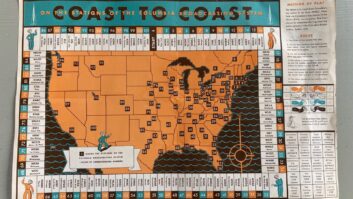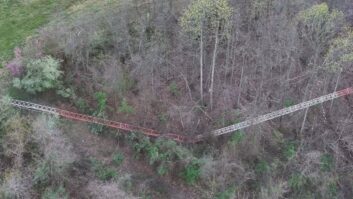Don Danko is a man impatient – impatient with the slow progress of surround sound for broadcast.
“We started seeing surround coming down the pike about five or six years ago,” he said. “Got in some equipment; but as is the case with first-generation gear, it wasn’t suitable.”
Danko is vice president of engineering and operations for Cincinnati Public Radio’s WGUC(FM) and a strong proponent of broadcast surround.
His station has been recording content in a surround format for four years, a decision Danko said was made by GM Richard Eiswerth and himself. The Corbett Studio, an audio recording and production service of Cincinnati Public Radio, records the Cincinnati Symphony Orchestra (CSO) concerts from their opulent Music Hall home. They later broadcast the concerts; post produced, utilizing one of the three “composite” surround encode/decode systems compatible with conventional stereo. In addition, a five-channel discrete mix, suitable for other subsequent surround applications, is recorded at the live event. The Corbett Studio also records several other Cincinnati ensembles such as the May Festival and has created commercial releases in surround as well.
The WGUC engineering staff is building a library of discrete surround music recordings even as it airs content knowing few listeners can currently hear the complete surround effect.
Mechanics
Even with modern consoles and proper monitoring, other, non-technical obstacles remain.
“We don’t have an outlet for the recording,” Danko said. Due to contractual obligations, WGUC can broadcast each CSO concert only once without paying additional performance rights fees to the musicians’ union. Also by contract, the broadcast must be local to Cincinnati. Danko said that without underwriting, the prospect of additional broadcasts is too expensive.
“Although we’re still testing the broadcast version of surround 5.1, we’re looking to figure out if there’s something we can do with record labels and/or other entities,” he said, referring to the CSO’s recording label Telarc. “We knew we’d have to come up with greater justification for the technology to show what surround could do for the CSO.”
Cincinnati Public Radio and Corbett Studio Recording and Mastering Engineer Alex Kosiorek has recorded the most recent season of the CSO and May Festival in stereo and simultaneously made a five-track surround-ready mix. He says he prefers to generate the stereo and surround 5.0 mixes simultaneously.
“Monitoring is not as difficult as it would seem, as we’re using a Yamaha DM1000, with supplemental equipment, and we can flip between stereo monitoring and 5.0 monitoring,” Kosiorek said.
He records the 5.0 mix to five separate tracks, at 24-bit resolution and an 88.2 kHz sampling rate, using Magix’s Sequoia recording software. The concert recordings are brought back to Cincinnati Public Radio’s Corbett Studio, where the concert itself is post-produced and program host tracks are added. Kosiorek encodes the concert into one of the composite surround systems from the five channels. He says he pays significant attention to the surround’s stereo downmix during the process, so it maintains stereo integrity.
Danko says a stereo downmix is in the ear of the beholder. “One of the arguments that has been used against composite surround encoding is that the downmix doesn’t perfectly represent the stereo recording. When you’re the one recording the show, who’s to say what the true stereo downmix should sound like? I don’t think people could argue when we record the CSO what the stereo downmix should sound like, because we’re the ones making the mix in the first place.”
Revenue goal
Is a post-produced concert preferable to a live broadcast? In Cincinnati, at least, listeners prefer the former. Danko said the station hasn’t aired live CSO concerts for some years.
“Our listeners are sophisticated and expect highly produced concerts – with no two-minute applause and hosts talking on and on to fill time, for example.”
Danko says a post-produced concert allows the host to concentrate on enhancing the listener’s experience through focused writing and concert details. As a consequence of the production process, the WGUC broadcast season lags behind the live CSO season.
“We air shows just prior to or during the live concert season to build enthusiasm and excitement,” Danko said. Apparently the listeners respond; according to Danko, the station often uses CSO concert and Cincinnati Opera performance tickets as giveaways and listeners snap them up. Danko says the station’s target demographic wants to hear the concerts – not only the CSO, but the festivals and groups that perform in the city’s other venues.
The Corbett Studio itself is a revenue resource for Cincinnati Public Radio; the station offers the studio’s services for clients who need production, on-location surround recording, forensic audio and restoration services.
“Cincinnati Public Radio has invested station resources in surround to gain expertise and knowledge for its clients as well,” Kosiorek said. “We’re trying to make the studio self-supporting. Our recording work at Music Hall when added to our in-studio clients helps accomplish that.”
Useful guide
Danko says that when pondering surround production, a station must have a clear understanding of the proper equipment and proper monitoring.
Kosiorek said one of the best references he’s read is available on The Recording Academy’s Web site. See www.grammy.com/pe_wing/5_1_Rec.pdf The publication is “Recommendations for Surround Sound Production,” provided by the academy’s Producers & Engineers Wing.
“It’s a technical document about surround and offers recommended standards that have become more universal at studio facilities,” Kosiorek said. “It’s a large PDF document, and it is meant to be absorbed.”
Danko says full-blown surround sources may not be appropriate for every type of music. “We were originally thinking 5.1, as it was the ‘big’ standard. But it wasn’t until Alex came on board that we settled on 5.0.”
Kosiorek said wryly that surround 5.0 is more appropriate for the majority of classical music, because the theatrical Low Frequency Effect (LFE) channel is superfluous – unless of course there’s a car chase in one of the movements.
With three brands of surround encoders commercially available – Dolby Pro Logic II, SRS Circle Surround and Neural 5225 – Kosiorek decided to try to test all three thoroughly during the CSO broadcast season. A problem, he said, was that broadcast rights to the appropriate material allowed only one on-air play. So the station would use similar but not identical content (comparing classical to classical, folk to folk, and so on) at different times.
The informal trials are run like this: The WGUC on-air announcer takes a composite surround-encoded concert CD, created by Kosiorek, and plays it in a Sony CDP500 CD player. The digital output of the CD passes to the digital input of the on-air studio’s Harris Legacy console, the digital output of which is sent to a fiber optic Intraplex transmission codec and travels to the transmitter site on an E-1 circuit.
An E-1 circuit contains 30 data channels of 64 kbps, as opposed to a T-1’s 24 channels. The WGUC E-1 bandwidth is allocated to two linear audio channels, a perceptually coded radio reading service channel and a variable-rate LAN connection. Remaining bandwidth is available for a future stereo perceptually coded audio channel.
The digital output of the Intraplex feeds an Orban Optimod 8500 processor to process the FM and HD signals and delay the FM feed to match the HD feed. The signal is then sent to a Harris Dexstar HD exciter and a Harris Digit FM exciter.
The surround signals are broadcast on the WGUC main FM channel and its 64 kbps HD Radio channel. Because broadcast radio reception has so few consumer devices that include surround decoding, Kosiorek said his evaluation technique has to be more elaborate.
“The funny thing,” he said, “is that we had to record it off-air and take it back to the station and listen to it over the proper decoder.”
Cincinnati Public Radio happens to own a radio receiver that includes the SRS Circle Surround matrix decoder. Danko or Kosiorek uses this receiver to listen to the broadcast in surround as it airs. But Danko notes that the receiver has no indicator showing that it’s actually receiving a surround-encoded signal.
No ‘winner’ yet
Which system sounds best? Kosiorek demurred.
Each “had significant tradeoffs and benefits. There are so many variables to each one,” he said. “One system will be more robust through the broadcast chain but it ‘challenges’ the analog FM signal and has higher amounts of L-minus-R information. Another system has less L-minus-R problems, but less channel separation.
“The best system,” Kosiorek said, “will be the least challenging to the listener and least impeding … There’s no clear-cut winner at this moment.” He said the Corbett Studio, along with the local Audio Engineering Society Chapter and NPR, recently teamed up to perform cross-compatibility tests. Results were pending as this issue went to press.
Danko wonders what the listener’s experience will be with compatibility. Will a single receiver simply contain chips to decode the popular surround schemes or will one system be adopted over the others?
In any event, Kosiorek said his goal is having the Corbett Studio support all recording technologies. He’d also like to be able to announce surround sound broadcasts to the public sooner, rather than later. While the station has mentioned surround tests in ancillary publications, he said, surround content is not pre- or back-announced as such on the air. And, Kosiorek said, he’s had no telephone calls complaining, “My stereo sounds weird.”
‘Do something fast’
If a station is to undertake surround recordings, Danko is emphatic that management, specifically the general manager and chief engineer, must be in total agreement and “extremely close in wavelengths” in their thinking. Otherwise, he said, the expense of acquiring equipment and the time to learn and perfect its use will be discouraging.
Danko cites a “trust loop” at WGUC in which the board of directors, the GM and the chief engineer trust each other’s judgments toward achieving the station’s goals.
After surround tests last year featuring recorded programs from the Cincinnati May Festival’s 2004 season, station executives put out an announcement stating, “The successful trial is a noteworthy development which sets WGUC apart as the first station in Ohio to broadcast locally produced surround sound programming.”
The station also had said that when it had committed in 2001 to a major investment in surround equipment for the Corbett facility, “its focus was geared toward recording major performance ensembles and using those recordings to produce superior surround sound encoded broadcasts, CDs and DVDs.”
Of the future, Danko again becomes an impatient man.
“I think we really have to come to an understanding on how we’re going to implement surround. One system or all systems? AM stereo lingered and withered. We have to get on this ‘craze,’ get on this technology. TV and satellite providers are already using this technology. We seem to be the last ones catching on to the 5.0 or surround. We can’t wait for HD Radio surround. Analog FM can broadcast surround now,” he said, his voice rising with conviction.
Although WGUC has been an HD Radio station licensee since 2003, he doesn’t think digital penetration will be significant soon and says it will take time to get receivers into consumers’ hands.
“In five, or six, or eight years, and we look again (at surround) when HD Radio has reached a critical mass, the technology and the sound of the encoders and decoders may have changed. We need to do something fast before the listeners go somewhere else.
“We should have this completely figured out and get receivers on the market in a year.”










